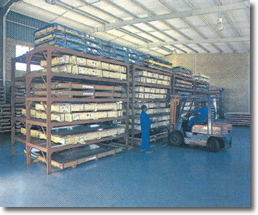- Martin steps in after Boshoff
- Stainless in the Automotive and Transport Industry
- Sassda team summits Kilimanjaro
- SATCA: Tank Containers
- Interfab Looks Ahead
- Going after Orders
- New Age Stainless Steel for Auto Industry
- A New Leader at Stalcor
- Difficult Times for Stainless Suppliers
- First stainless test batch for Iscor
- Campbell sees Exciting Future
 There is no real service centre locally in terms of the US definition of a one-stop facility for everything to do with stainless steel, says Euro Steel director, Colin Wilson. The biggest dedicated service centre locally is Bobfab of Spartan, but even this company does not do everything.
There is no real service centre locally in terms of the US definition of a one-stop facility for everything to do with stainless steel, says Euro Steel director, Colin Wilson. The biggest dedicated service centre locally is Bobfab of Spartan, but even this company does not do everything.
“We have separate concerns for slitting, bending, cutting, and polishing, for example, because there is insufficient volume in our too-small market,” says Wilson.
The result has been a fragmented sector with numerous niches, where it is difficult to determine the overall potentiality due to the dispersal of skills and activities. This has led to a disproportionately-high number of mini-merchants in this sector, the so-called ‘bakkie brigade’.
Euro Steel is a second-tier distributor of Columbus Stainless, and has changed its focus from being a primary importer to now being a primary supplier through the Columbus network. It mainly offers a merchanting service, as well as importing specials on demand that are unavailable locally.
The company’s customers run the gamut of industry, from catering to cutlery and hollowware, to the chemical sector, light and heavy fabrication, and building and engineering. “The local ‘service centres’ are among our customers, and we maintain a very good relationship with them,” says Wilson. “We are very close, and we do not wish to compete with each other; this is a very incestuous industry.”
Everyone feeling the squeeze
He comments that the South African stainless steel industry – except for the automotive and tank container sectors – has shrunk in the last year, with “everyone feeling the squeeze.”
Companies are trying to regain lost margins in the belief that competitors have encroached on their turf, but this is simply due to declining demand in the local market.
“We are small enough to maintain our flexibility with regard to meeting all our customers’ requirements, but big enough to finance those business deals that we do need,” explains Wilson.
The local situation is in total contrast to the situation abroad, where the global stainless steel industry is growing at between 3% to 4% a year, and is requiring a capacity of a million tons every two years to meet global demand.
“Overseas consumption of stainless steel is growing in leaps and bounds as companies move away from the ‘dirty’ aspects of steel to the architectural, maintenance-free, hygienic, aesthetic, and environmental benefits of stainless,” says Wilson.
The expense factor
The problem in the African continent is that the expense factor is inhibiting consumption and market growth. “The current situation is one of mass rationalisation in the industry; fabricators are now competing against overseas suppliers, and inefficiencies are being rooted out.
“’Carnage’ is too strong a word, but there have been insolvencies, closures, and much pain,” says Wilson.
He explains that, in the new area of globalisation, multinationals can choose to invest wherever it is most beneficial for them to do so. “Local companies can now invest offshore, so we are likely to see fewer capital projects coming off locally.”
The false economics of apartheid had created an industry buffered by high tariff barriers and sanctions, but these artificial protective measures had now been stripped away. “We need to secure a market for our fabricated products as there is no longer sufficient growth in the domestic market; thus we need to tie up with the European Economic Community,” argues Wilson.
Related to this, it would be advisable that Columbus Stainless come to some sort of agreement with the proposed new Ferrostaal stainless steel plant at Coega in the Eastern Cape, if it does indeed go ahead. “Generally, every mill in the world has a big enough domestic market to support itself, but Columbus does not – and now a new player is being mooted.”
We are lagging behind
Commenting on the advent of information technology in the stainless steel sector, Wilson says that the industry “is lagging the world in Internet technology.” He predicts that this will become a big factor in the future, as it will be an “absolute must” for domestic fabricators and other players so as to maximise their exposure in the market.
“This is an increasingly difficult market where our main challenge is to maintain our leading position, and continue to offer the service and flexibility that has gotten us where we are today,” says Wilson. “Whereas in Europe things are done on a far vaster scale, today in South Africa you have to focus on niches and make them as viable as possible,” he concludes.

